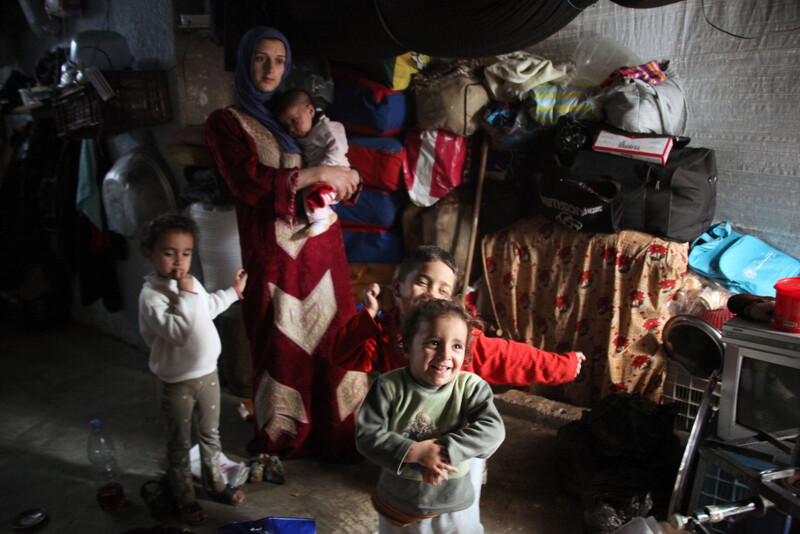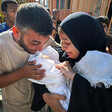Rights and Accountability 14 March 2015

A family takes shelter in a United Nations facility in Syria.
UNRWASix percent of the Syrian population has been killed or wounded, and life expectancy in the war-torn country has plummeted by twenty years, according to a disturbing new report.
Since the outbreak of civil strife in 2011, “the population of Syria [has] hollowed out by 15 percent during the conflict as 3.33 million Syrians fled as refugees to other countries,” according to the Damascus-based Syrian Centre for Policy Research.
The group adds that deteriorating conditions have caused people “to place their lives and fortunes at risk in the hands of illegal traffickers in the hope of reaching save haven on European shores.”
Thousands have drowned in the Mediterranean Sea “or been abused and robbed by human traffickers and criminal gangs.”
Mediterranean drownings
As harsh winter weather conditions subside, human smuggling in the Mediterranean increases.
The Reuters news agency reported on 4 March that 941 migrants were rescued by the Italian coast guard in seven separate operations south of Sicily within in a 24-hour period.
“There is still no detailed breakdown on their nationalities, although most of the survivors appear to be Sub-Saharan Africans and Eritreans, as well as Syrians and Palestinians,” the International Organization for Migration (IOM) stated last week.
At least two Palestinians were among the sixty migrants who drowned after their boat capsized off the coast of Sicily on 4 March. A further sixty persons remain missing.
A Palestinian diplomat told the Ma’an News Agency that at least 59 Palestinians were on board the boat, which was believed to be carrying approximately 180 migrants.
A more detailed report published by Ma’an’s Arabic-language site states that nine people aboard the boat were from Gaza, including four children. Other Palestinian passengers included refugees from Yarmouk camp, near the Syrian capital, and the camps in Lebanon.
“Two of the dead migrants were identified as Ahmad Khalid Hasan, 17, and Mahmoud Hmeid, 23, from Ein al-Hilwe refugee camp in Lebanon,” according to the English-language report.
Five thousand people lost their lives while migrating last year, most of them in the Mediterranean Sea. It was the worst year on record for migrant deaths. And 2015 is set to be even more deadly.
Six hundred people have lost their lives while migrating so far this year, a huge increase from the one hundred deaths recorded in the equivalent period of 2014, IOM reported this week.
The Mediterranean is the world’s most deadly migration route. But the prevailing despair in places like besieged Gaza, the marginalized refugee camps in Lebanon and war-torn Syria compel increasing numbers to embark on the journey.
Destruction of Syria
The report from the Damascus-based Syrian Centre for Policy Research, published in cooperation with the United Nations agencies UNRWA and UNDP, details the shocking economic and social conditions from which people are fleeing in Syria.
With the country’s resources and capital reallocated “to the machinery of war,” the Syrian economy has collapsed and become regionally fragmented.
The total economic loss since the start of the unrest in Syria in early 2011 until the end of 2014 is estimated at $202.6 billion, according to the report.
Unemployment “surged” from almost 15 percent in 2011, the year that the strife began, to 57.7 percent by the end of last year, when there were 3.7 million unemployed persons.
“Armed conflict, economic disintegration and social fragmentation have transformed the human geography of Syria,” the study adds, resulting in “a hollowing population” which fell from 20.87 million in 2010 to just 17.65 million by the end of last year.
The transformation of Syria’s demography is even more stark when comparing the real population versus the potential population projected by pre-conflict growth rate figures.
“If the conflict had not emerged and the Syrian population growth rate continued at 2.45 percent annually, the total population would have reached 22.99 million inhabitants by the end of 2014,” the report states. “Thus, counterfactually, the potential versus the real population declined by 23 percent.”
By the end of last year, more than half of the population had moved or fled because of hostilities. Approximately 58 percent of this group were internally displaced within Syria, “while 28 percent fled as refugees and 14 percent migrated to other countries.”
With an estimated 3.33 million people fleeing the country by the close of 2014, including 2 million children, refugees from Syria now constitute the second largest refugee population in the world, after the Palestinians.
Turkey edged out Lebanon as the major host of Syrian refugees last year, with 35.1 percent of refugees sheltering in the former and 34.5 percent in Lebanon. “Jordan hosted 18.7 percent of Syrian refugees, while Iraq provided haven for 6.9 percent,” the study adds.
The deteriorating conditions have plunged four in every five Syrians into poverty, with 30 percent of the population in abject poverty, unable to meet their basic food needs. The abject poor in conflict zones “face special difficulty” including hunger, malnutrition and even starvation.
Schools attacked
Half of all school-age children were no longer attending school during the 2014-15 academic year, “with almost half of all children already losing three years of schooling.”
“The basic educational achievement of Syria in 2014 was the second worst performance in the world,” the report states, while “The widely different attendance rate within the different regions of the country is an indicator of growing inequality.”
There were 68 attacks on schools in Syria last year, including the November attack on a primary school near Damascus which killed eleven children, according to a new report by the United Nations children’s fund UNICEF.
One in five schools in Syria has been damaged, destroyed or is currently sheltering internally displaced people, according to UNICEF.
Life expectancy plummets
Meanwhile, six percent of the country’s population has been killed, maimed or wounded as a result the armed conflict, which has claimed 210,000 lives and 840,000 injuries.
“Equally horrendous is the silent disaster that has reduced life expectancy at birth from 75.9 years in 2010 to an estimated 55.7 years at the end of 2014, reducing longevity and life expectancy by 27 percent,” according to the Syrian Center for Policy Research study.
The country’s health infrastructure has been devastated, with only half of all primary health centers existing before the conflict still in operation at the end of last year. Most hospitals face a shortage of health workers, particularly emergency physicians.
Physicians for Human Rights has documented the killings of more than 560 medical personnel since the beginning of the conflict, the UNICEF report notes, and “in one part of Aleppo, Syria’s largest city, twenty doctors remain to serve the needs of about 300,000 civilians.”
Meanwhile, UNICEF states, “as many as 80,000 young children remain inaccessible and have missed out on scheduled polio vaccinations” after a major mobilization of health resources after an outbreak of the disease in late 2013.
Provision of humanitarian aid in Syria, though substantial, “remains far below the needs of people within the present catastrophic situation,” the Syria crisis report finds.
Yarmouk
Fighting and siege prevents the distribution of humanitarian aid, including in long-suffering Yarmouk camp.
UNRWA, the UN agency for Palestine refugees, was able to to deliver food parcels to more than three hundred families on 5 March — the first successful distribution since 6 December.
Yarmouk was once the largest population center of Palestinians in Syria. Before the violent upheaval in the country, the camp’s residents “comprised some 180,000 Palestinian refugees and several hundred thousand Syrian nationals,” according to Amnesty International.
Now only approximately 18,000 civilians remain in the camp.
Yarmouk has been under siege by Syrian government forces since December 2012 after armed rebels entered the camp. Dozens died from starvation there after government forces “began to prevent all access to Yarmouk” in July 2013, states Amnesty.
Residents have not had reliable electricity since then, as the main supply was cut, according to UNRWA.
Most Palestinians in Syria are refugees from the 1948 ethnic cleansing of Palestine and their descendants, as well as those displaced after the Israeli military occupation of the West Bank and Gaza Strip in 1967. Israel refuses to respect the right of Palestinian refugees to return to their land and property.
Last year UNRWA was able to distribute the “equivalent to only 400 calories per resident per day, drastically short of the World Food Programme recommended daily amount of 2,100 calories for civilians in crisis zones.”
This week the agency’s spokesperson Chris Gunness warned a funding shortfall of hundreds of millions of dollars:





